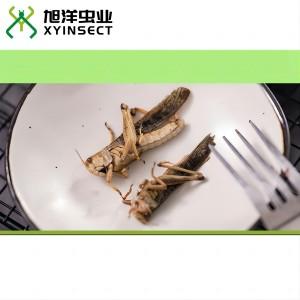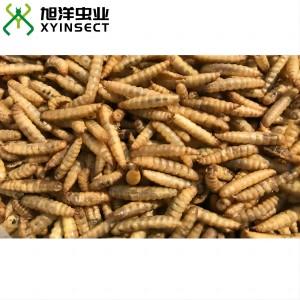Description
Silkworm Pupae Meal Powder Feed Grade
- Silkworm pupae meal, silkworm pupae, silkworm meal, silk worm meal, spent silkworm pupae, non-defatted silkworm pupae meal, non-deoiled silkworm pupae meal, Eri silkworm pupae meal, Muga silkworm pupae meal
Bombyx mori Linnaeus, 1758 [Bombycidae]
Silkworm Pupae Meal was made of dried whole silkworm pupae without any addtives.
Packing & Delivery
Packing Details: 20kg, 25kg Kraft Paper Bag, 15MT/20'fcl or as required
Port: Qingdao or Shanghai Port
Lead time: 3-4 Weeks
OEM: Available
Supplying Ability
100MT per Month
Tables of chemical composition and nutritional value
-
Avg: average or predicted value; SD: standard deviation; Min: minimum value; Max: maximum value; Nb: number of values (samples) used
-
Silkworm pupae meal, non-defatted, dried

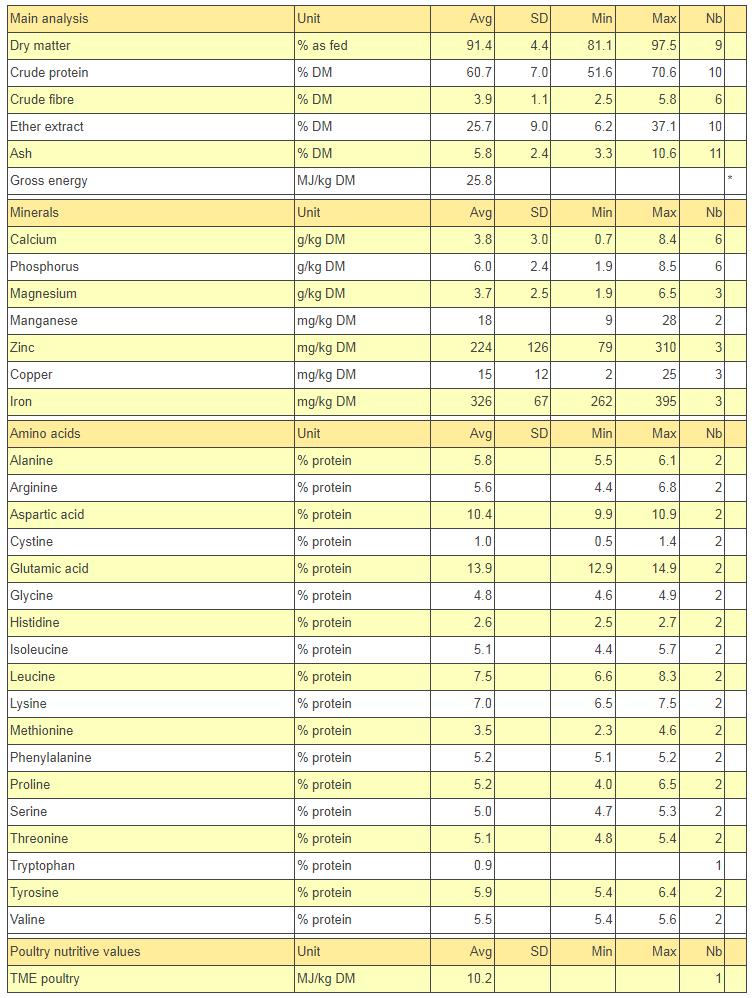
The asterisk * indicates that the average value was obtained by an equation.
References
Coll et al., 1992; Devegodwa et al., 1986; Fagoonee, 1983; Göhl, 1982; Gowda et al., 2004; Hossain et al., 1993; Hossain et al., 1997; Ioselevich et al., 2004; Jintasataporn, 2012; Longvah et al., 2011; Narang et al., 1985; Rao, 1994
Nutritional attributes
Silkworm pupae meal is a protein-rich feed ingredient with a high nutritional value. Its crude protein content ranges from 50% DM to more than 80% DM (for defatted meal). The lysine (6-7% of the protein) and methionine (2-3% of the protein) contents are particularly high. However, the true protein (calculated as the sum of amino acids) in silkworms was found to correspond to only 73% of the crude protein content (Finke, 2002), which was explained by the presence of chitin, since this component contains nitrogen. However, the chitin content of pupae meal is relatively low, about 3-4% DM (Finke, 2002; Suresh et al., 2012). The presence of chitin and insoluble protein may also explain the presence of fibre, and values of 6-12% DM of ADF have been reported (Finke, 2002; Ioselevich et al., 2004). Undefatted pupae meal is rich in fat, typically in the 20-40% DM range. Defatted meal contains less than 10% oil in the DM. Silkworm oil contains a high percentage of polyunsaturated fatty acids, notably linolenic acid (18:3), with reported values ranging from 11 to 45% of the total fatty acids (Ioselevich et al., 2004; Rao, 1994; Usub et al., 2008). Compared to other animal by-products, silkworm pupae meal is relatively poor in minerals (3-10% DM).
Potential constraints
Silkworm pupae meal does not appear to contain toxic components. In poultry, notably, the mortality of birds fed diets containing silkworm meal is similar to that of animals fed more conventional protein sources (Dutta et al., 2012).
Silkworm meal is a very valuable protein supplement for ruminants, due to its highly undegradable protein content and favourable amino acid profile. Limitations in its use as ruminant feed result from the high oil content. Therefore, fat extraction of silkworm meal is of interest when it is fed in large amounts (Ioselevich et al., 2004).
Effective in situ nitrogen degradability of silkworm meal is quite low. Reported effective degradability values (5%/h outflow rate) for undefatted silkworm pupae were 29% and 25% (Chandrasekharaiah et al., 2002; Ioselevich et al., 2004) and 20% for defatted meal (Chandrasekharaiah et al., 2004). This results in large amounts of undegradable protein, especially from the defatted meal, which is richer in protein. Lysine and methionine, which are considered to be the two major limiting amino acids for milk production, both have a low in situ disappearance of 26% (24 h incubation, 5%/h outflow rate), which indicates that the bypass protein fractions of silkworm pupae are good sources of lysine and methionine for ruminants (Sampath et al., 2003). However, the undegradable protein fraction has a relative low intestinal protein digestibility of 53%, as estimated by in vitro pepsin-pancreatin solubility (Ioselevich et al., 2004).
Undefatted silkworm meal safely replaced 33% of groundnut cake in fattening diets for Jersey calves without decreasing performance, resulting in a cheaper feed. The protein digestibility of the silkworm meal-based diet was higher than that of the groundnut cake diet (Narang et al., 1985). In lambs fed a basal diet of barley and hay (75:25), the isonitrogenous substitution of a potato protein supplement with undefatted silkworm meal resulted in similar increases in nitrogen and energy retention (Ioselevich et al., 2004). The crude protein digestibility of defatted Tussore silkworm pupae fed with wheat straw and molasses to sheep was about 70% (Khan et al., 1971).
Limited information is available on the utilization of silkworm pupae for pigs. Two experiments showed that silkworm pupae meal was a good replacement for traditional protein sources. In Brazil, it was possible to replace up to 100% of soybean meal in diets for growing and finishing pigs with undefatted silkworm meal with no effect on growth performance and carcass characteristics. There was a negative effect on intake when the substitution rate was higher than 50%, which was attributed either to the higher energy density of the diet or to a lower palatability. However, the lower intake was compensated by a better feed conversion rate, which may have been due to the higher lysine content of the silkworm-based diet (Coll et al., 1992). In India, silkworm meal could fully replace fish meal in the diet of growing and finishing pigs without altering carcass and meat quality and blood parameters (Medhi, 2011; Medhi et al., 2009a; Medhi et al., 2009b).
Poultry
Silkworm pupae meal is a valuable protein source that can be used in poultry feeding, though it is of slightly lower quality than fish meal. High amino acid digestibilities (lysine 94%, methionine 95%) were determined in geese (Penkov et al., 2002). Unless otherwise specified, the silkworm pupae meal used in the studies cited in the tables below was not defatted, though this is not always clear from the papers or abstracts.
Broilers
Numerous trials have shown that replacing 50% of the main protein source (fish meal in most of the experiments) is usually safe, though mineral supplementation may be required. Total replacement is sometimes possible but tends to result in a lower performance. Inclusion rates are typically in the 5-6% range.
One study indicated a growth stimulating effect in growing chicks correlated with the activity of ecdysteroid, a hormone involved in the metamorphosis of the pupae (Fagoonee, 1983a; Fagoonee, 1983b), though this has not been confirmed since. Treating deoiled silkworm meal with 70% acetone for 12 hours was shown to improve broiler performance (Venkatchalam et al., 1997). Trials in which traditional protein sources in broiler diets were replaced with silkworm meal are summarized in the table below.
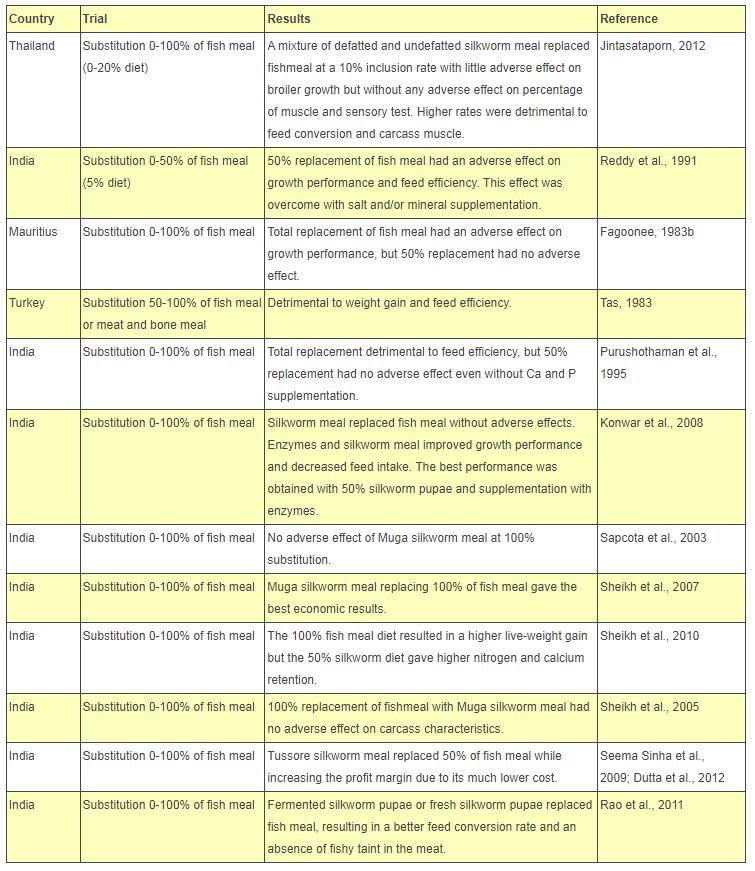
Laying hens and breeders
Silkworm meal seems to be well accepted by laying hens (Saikia et al., 1971; Joshi et al., 1979; Joshi et al., 1980) but studies are less numerous than for broilers. One study found that silkworm pupae meal was detrimental to the breeding performance of breeder males (Mahanta et al., 2004). Some of the data is summarized in the table below.
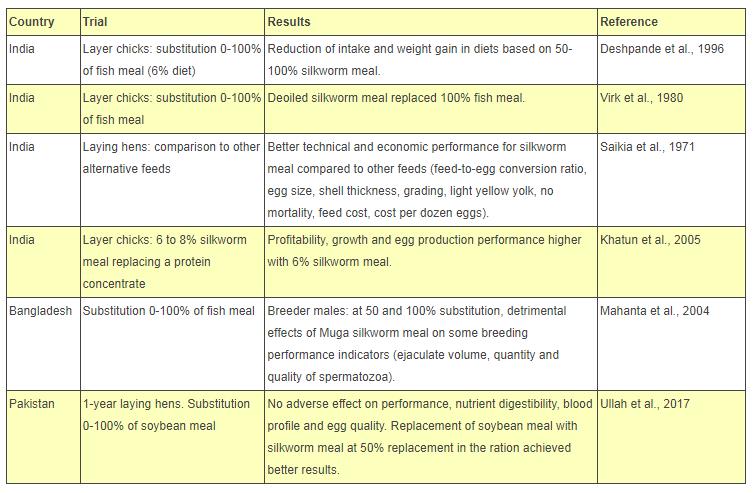
Dried silkworm meal totally replaced soybean meal in balanced diets for growing rabbits without any problem (Carregal et al., 1987). In China, silkworm meal is a traditional ingredient in rabbit feeds. In a trial evaluating a new rapeseed meal, 7% silkworm meal was included in the control diet (Liu et al., 1987).
Silkworm pupae meal is a valuable protein source for many fish species.
Cyprinids
High levels of silkworm meal (about 30%) can be fed to cyprinids.
Common carp (Cyprinus carpio)
When silkworm meal replaced part, or all, of the fish meal in common carp (Cyprinus carpio) diets, similar performance (growth and feed conversion) was observed (Jeyachandran et al., 1976; Erencin, 1976; Borthakur et al., 1998a; Borthakur et al., 1998b; Nandeesha et al., 1990; Nandeesha et al., 1989; Rahman et al., 1996). Undefatted silkworm pupae meal was safely used up to 50% without hampering growth and meat quality of the fish (Nandeesha et al., 2000). In a comparison between silkworm pupae meal and plant leaf meals (alfalfa and mulberry), feed conversion efficiency, nutrient digestibility and nutrient retention were better for diets based on silkworm meal than for diets based on plant leaf meals (Swamy et al., 1994).
Silver barb (Barbonymus gonionotus)
In silver barb fingerlings (Barbonymus gonionotus), highest growth rates were observed in fish fed a diet with about 38% of total dietary protein replaced by silkworm pupae meal (Mahata et al., 1994).
Mahseer (Tor khudree)
Mahseer fingerlings (Tor khudree) fed a diet containing 50% defatted silkworm pupae at 5% body weight had better growth and survival rates than fingerlings fed no or lower amounts of silkworm pupae (Shyama et al., 1993).
Other cyprinids
Fermented silkworm pupae silage or untreated fresh silkworm pupae paste were incorporated in carp feed formulations, replacing fish meal, in a polyculture system containing the Indian carp (Catla catla), mrigal carp (Cirrhinus mrigala), rohus (Labeo rohita) and silver carp (Hypophthalmichthys molitrix). Survival rate, feed conversion ratio and specific growth rate were better for fermented silkworm pupae silage than for untreated silkworm pupae or fish meal (Rangacharyulu et al., 2003). In rohu, undefatted silkworm pupae and defatted silkworm pupae produced significantly better protein digestibility values than fish meal (Hossain et al., 1997).
Mozambique tilapia (Oreochromis mossambicus)
Mozambique tilapia (Oreochromis mossambicus) were able to utilize the protein of both defatted and undefatted silkworm meal (apparent protein digestibility of 85-86%) (Hossain et al., 1992).
Chum salmon (Onchorhynchus keta)
Chum salmon fry (Onchorhynchus keta) fed over 6 week diets supplemented with 5% silkworm pupae meal at the expense of fish meal did not show improvement in growth rate and protein content, though silkworm supplementation enhanced feed efficiency (Akiyama et al., 1984).
Asian stinging catfish (Heteropneustes fossilis)
Silkworm pupae meal was used as a substitute for fish meal at up to 75% of the protein in Asian stinging catfish (Heteropneustes fossilis) diets without adverse effects on growth (Hossain et al., 1993).
Walking catfish (Clarias batrachus)
Undefatted silkworm pupae was found to be a suitable fish meal substitute in diets for walking catfish (Clarias batrachus). Digestibility of the crude protein in silkworm meal was found to be similar to that of fish meal (Borthakur et al., 1998a; Borthakur et al., 1998b).
Japanese sea bass (Lateolabrax japonicus)
In Japanese sea bass (Lateolabrax japonicus), the energy digestibility of undefatted silkworm pupae meal (73%) was lower than that of poultry by-product meal, feather meal, blood meal and soybean meal, but comparable to that of meat and bone meal. Protein digestibility was also lower (85%) than that of poultry by-product meal, blood meal and soybean meal but it was comparable to that of feather meal and higher than that of meat and bone meal (Ji WenXiu et al., 2010).
Shrimp growth trials showed that digestive efficiency was reduced when silkworm meal was used to replace fish meal (Sumitra-Vijayaraghavan et al., 1978).
Abalone (Haliotis discus hannai Ino.)
In juvenile abalones (Haliotis discus hannai Ino.), a combination of soybean meal and silkworm pupae meal replaced fish meal, resulting in slightly higher survival rate and better growth performance (Cho SungHwoan, 2010).




